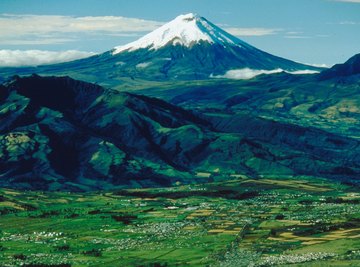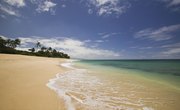
Erosion is the wearing down of soil or rock by the action of wind, rain, rivers, ice and gravity. A volcanic eruption produces lava, ash and gases. This debris creates new sediments, igneous rock formations and landforms. Volcanoes cause limited erosion directly; the underside of a new lava flow scours topsoil or loosely consolidated sediments. Volcanic eruptions are the indirect causes of substantial erosion through the action of volcanic debris on the atmosphere, land and water.
Climate
Volcanic eruptions produce an atmospheric haze composed of suspended dust particles, or aerosols. These absorb solar radiation, scatter it back into space, and produce a net cooling effect on Earth. The 1815 Mount Tambora eruption produced an atmospheric haze that spread throughout the Northern Hemisphere and caused the following year, 1816, to be the “year without a summer.” Snowfall and frost occurred in June, July and August. This precipitation eroded landscapes.
Acid Rain
Volcanoes emit sulfur and carbon dioxide gases. These gases dissolve in rainwater and produce an acidic precipitation. Acid rain erodes limestone by dissolving the carbonate rock and produces crevasses and caves.
Lahars
Lahars are catastrophic mudflows. Snow and ice top the large volcanoes characteristic of those in the Rocky Mountains of North America and Andes Mountains of Central and South America. The heat produced by an eruption melts the snow that, in turn, triggers massive landslides down the volcano’s slope. These uproot trees, and erode soil and rock cover. Lahars can destroy entire communities. The 1985 eruption of Nevado del Ruiz in Colombia killed 23,000 people.
Dams
Substantial amounts of lava, rock debris and ash from a volcanic eruption is capable of impounding river courses and creating lakes. When water pressure breaches this volcanic barrier, the subsequent flooding erodes sediment downstream. Lava dams in the Grand Canyon breached throughout the Pleistocene era between 1.8 million and 10,000 years ago.
References
Resources
About the Author
Based in London, Maria Kielmas worked in earthquake engineering and international petroleum exploration before entering journalism in 1986. She has written for the "Financial Times," "Barron's," "Christian Science Monitor," and "Rheinischer Merkur" as well as specialist publications on the energy and financial industries and the European, Middle Eastern, African, Asian and Latin American regions. She has a Bachelor of Science in physics and geology from Manchester University and a Master of Science in marine geotechnics from the University of Wales School of Ocean Sciences.
Photo Credits
Jupiterimages/Photos.com/Getty Images
